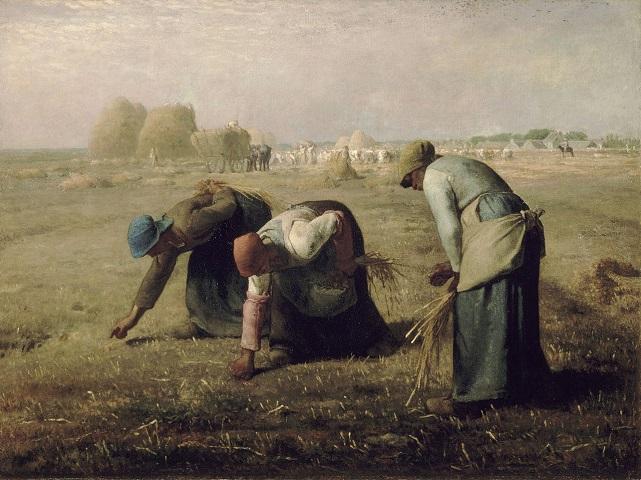The Harvesters or The Gleaners

"The Harvesters" or "The Gleaners" is a renowned painting created by the French artist Jean-François Millet. This masterpiece is the result of ten years of meticulous research carried out by Millet, focusing on the lives of the harvesters or gleaners. These women were tasked with collecting leftover ears of grain after the harvest, a laborious and essential task that had to be completed before nightfall. Through this painting, Millet sought to shed light on the plight of the rural proletariat, highlighting the harsh realities of their daily lives.
The painting caused quite a stir when it was first exhibited at the Paris Salon in 1857, drawing criticism from the French upper classes who were uncomfortable with its unflinching portrayal of the working class. Despite the controversy, Millet remained steadfast in his commitment to depicting the true face of the laboring masses, aiming to raise awareness about the challenging conditions faced by many in rural France. "The Harvesters" became a powerful symbol of patriotism during World War I, inspiring young men to enlist and serve their country.
Beyond its historical significance, "The Harvesters" serves as a poignant reminder of the value of hard work and the importance of respecting those who toil in the fields to provide food and sustenance for society. The painting captures the essence of rural life, showcasing the dignity and resilience of the working class amidst adversity. Millet's choice of subject matter reflects his deep empathy for the common people, elevating their labor to a position of honor and respect.
As visitors gaze upon "The Harvesters" in museums or galleries, they are invited to contemplate the timeless themes of labor, sacrifice, and social justice that resonate throughout the painting. The intricate details and emotive expressions of the gleaners convey a sense of solidarity and shared humanity, bridging the gap between the viewer and the subjects of the artwork. Through this masterpiece, Millet invites us to reflect on the interconnectedness of all individuals, regardless of social status or occupation.
In conclusion, "The Harvesters" stands as a testament to the enduring power of art to provoke thought, evoke emotion, and inspire change. It continues to captivate audiences with its raw authenticity and profound message, serving as a lasting tribute to the resilience and fortitude of the working class. Whether admired for its technical skill, historical significance, or social commentary, this iconic painting remains a timeless masterpiece that speaks to the universal experiences of labor and humanity.
© ChatGPT 3.5
With this painting, Millet was accused of being a socialist by many critics and members of the French upper class. Millet only wanted to represent the people around him, since he was not a rich man. That is why he showed the rural workers as they truly are and not with idealizations or falsehood that prevailed in many paintings of this style. The rural workers would come from the Normandy region, a place where Millet lived.
The importance of this canvas lies in the fact that it became a reference for the Barbizón School, in which several artists went to live in the Barbizón area because they rejected the pictorial canons, as well as the social canons of the time. Although Millet was never really that attached to the students of this school, nor to the school itself, due to his artistic temperament and his personal ideals, he managed to influence artists of the stature of Van Gogh and it is precisely this romanticism towards class. hardworking which impressed Vincent.
With The Harvesters, Millet began a series of paintings he made about gleaning, in which he changed the paint for different formats.